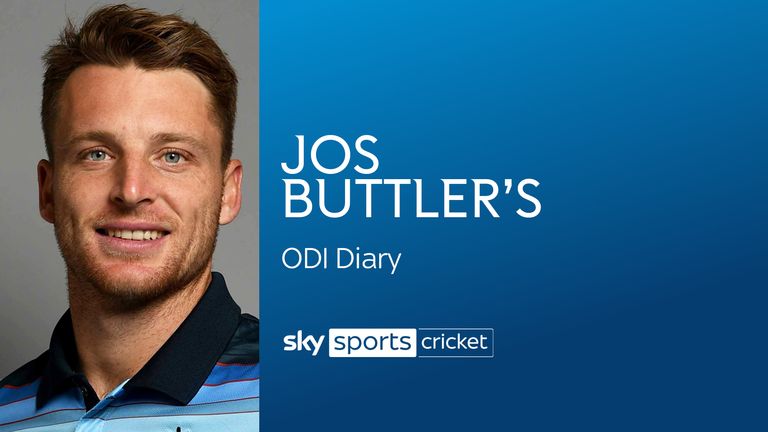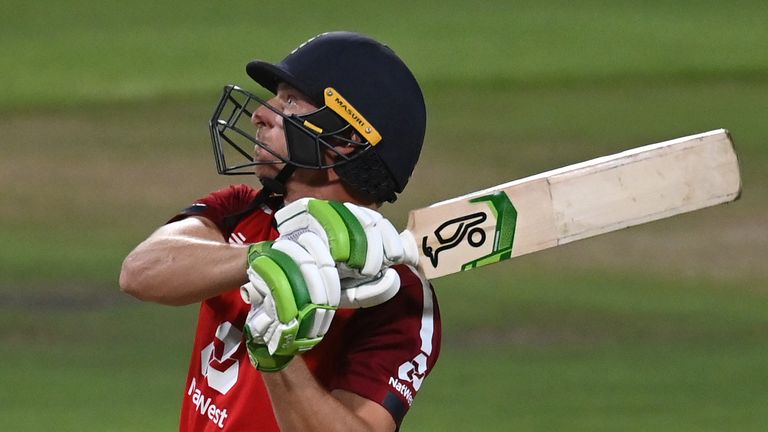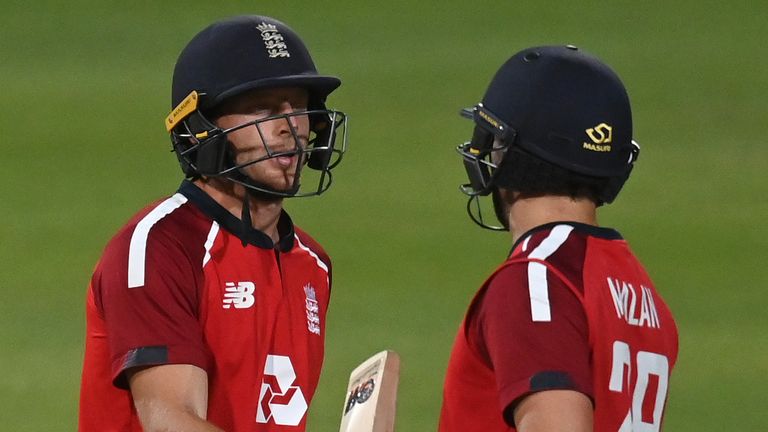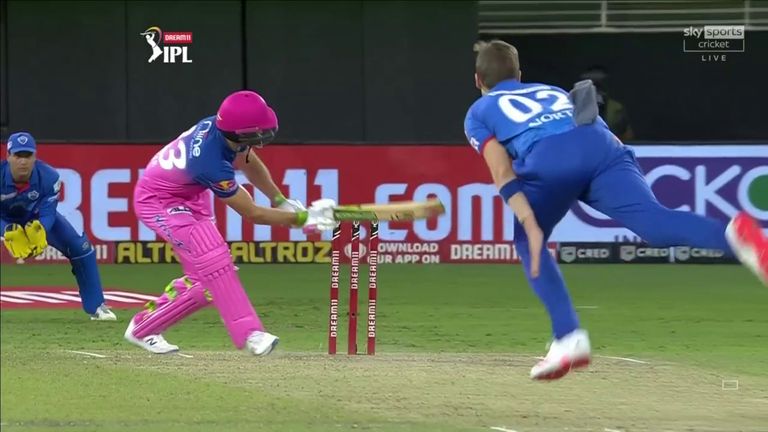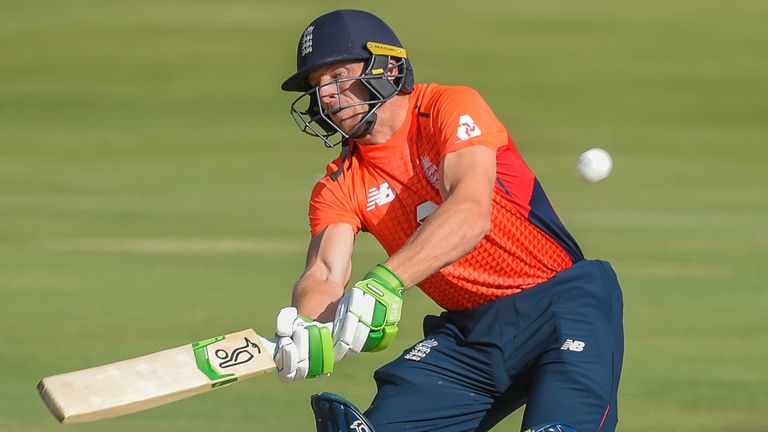Jos Buttler's guide to white-ball batting ahead of England's ODI opener against South Africa
In his latest column, England star Jos Buttler provides his guide to batting in white-ball cricket as he explains how he goes about constructing a game-plan, controlling a run-chase and the calculations he makes before attempting a ramp shot
Sunday 6 December 2020 12:50, UK
Jos Buttler is one of the world's best and most destructive white-ball batsmen and in his latest Sky Sports column, the England star explains how he goes about his business in the middle...
Key principles
The key thing is to assess the situation, the conditions and the game situation. That's the case whether I'm opening in a T20 or I'm batting in the middle-order in an ODI and you're reacting to what's happening in the game, almost looking at the scoreboard and trying to then read how you have to play.
I try to come to the crease with intensity and a positive mindset, looking to score all the time and trying not to face dot balls, I like to try and be busy and get my innings going early.
Waiting to bat
I'm quite engaged in the game, I enjoy watching the guys bat and seeing how the conditions are playing. If there's a TV, I quite like just being in the dressing room and watching on there. You get a good view of what's happening, some slow-motion replays so, for example, you can see which slower ball someone has bowled.
If I'm next in to bat, a lot of the time I'm just walking around with a lot of nervous energy and getting ready to bat. I try to watch a bit and gain as much information as I can.
Constructing a game-plan
There is always a stream of information coming back to the dressing room. If someone has got out, they might come in and say how the wicket is playing or how certain guys are bowling. Every over the game is changing so you're formulating am ever-evolving plan as the game unfolds. You might be thinking you could have 20 overs to bat but then another 10 overs go by before you're in so when you go out it might be a bit different.
When you get out to the middle, you're looking to strike up a partnership straight away and your partner will give you a bit of information about certain bowlers and how the wickets are playing.
Starting an innings
I look to get into my innings and get off the mark as quickly as possible then get running. I think that now I'm a bit older, I don't fret too much about it or certainly not as much. I still want to get up and running but if someone does bowl a few good balls and I have to face a few dots, I feel like it's OK and I can just get myself in. But in an ideal world, it is nice to get off the mark straightaway.
Targeting opposition bowlers
That can change. On any given day, one bowler might be bowling really well and others not so well or the conditions don't suit them quite so much. You have to react to that in the middle, sometimes you might have a short boundary on one side and you feel like 'this is an over that I can target' so you'll try and go for it and commit to that.
Batting in the middle-order in one-day cricket you do have to be really reactive and then make clear, calm and smart decisions on your feet in the middle a lot of the time. Certain bowlers will feel easier to face on one day than they do another day so who you target can always change.
Trusting your instincts
When I'm batting at my best, I think I'm very instinctive. Your dream as a batsman, when you're in a perfect flow, is that you are just reacting to what happens; it's almost like you're a bit of a computer, you scan the field, put the information in and just go on to autopilot. That's the dream, to be in that frame of mind.
Other days you don't get there and have to be a little bit more premeditated. Sometimes that works well and you get a good read on a bowler but other days you're trying to guess and you're guessing wrong. In an ideal world, you're almost trying to let your subconscious bat for you; put good information in, make smart decisions and then trust yourself that you'll react.
Matchups
In international cricket, you tend to know which bowlers are likely to come on when you come out to bat. Naturally, as batsmen we prefer certain bowlers or our techniques are matched up to play certain guys better than others.
You tend to get a bit of a read on who you think the opposition will attack you with. It's ever-evolving, decision-making on your feet and reacting to the situation but it is always important to be aware of the scoreboard and who has got overs left, how they might attack you but also how you can counter-attack them.
You don't want to get into a negative mindset of thinking 'this guy has come on to get me out so I'll play it safe' - you have to focus on yourself and how can you can put pressure back on the opposition as well.
Setting a total vs controlling a run-chase
It is different depending on whether you're batting first or chasing. When you're chasing it is really clear what is required of you. I might walk in and know that there are 20 overs left and we need six and a half an over, so there is a very clear thing that needs to be achieved.
When you're assessing, you need to work really well with the guys who have batted ahead of you. They might suggest that 320 is a par score on this wicket so I'll keep an eye on that and work towards it if the game is going that way.
As you get more experienced, you can tend to work out how and when to play situations and what a good score will be. I like to look what the end goal is and work back from there. What are the steps to get to that? What do I need to do in this over to set me up to get to that end goal?
Risk-taking and committing to the shot
A lot of the time you are trying to take calculated risks and read bowlers. The field might give you a clue and make you think it is 80-20 that a bowler will a bowl a yorker, for example, so then hopefully things become more in your favour when you play those risk-taking shots.
It is not just a blind slog or a big gamble, hopefully there is a good reason for you to take that shot on and I try and tell myself that if he is at the end of his mark and I'm 100 per cent in, then I'll go for it.
If I'm not 100 per cent in then I'll back out of it because, especially with those premeditated shots like the ramp shot, you have to be fully committed to it. If you're not then that fear of getting out creeps in and that is something you have to keep out of your mind as a batsman. If you're afraid of getting out then you don't play with any freedom.
Countering death bowling
In one-day cricket, overs 10 to 40 you're only allowed four guys outside the circle and in the last 10 you can have five out so sometimes if we're playing really well and we haven't lost too many wickets, you can really attack that 30-40 over period when there are only four guys out. Again, you just have to react to what's happening on the field at a certain time.
When people switch to death bowling, you have to try to counter yorkers and think about whether they're going to bowl more slower balls or bouncers. Generally, it is yorkers that are considered death bowling and so it is about trying to line yourself up for that ball.
The margin for error for bowlers these days is really small, lots of people practice range-hitting all the time and if you just miss a yorker then it could go the distance. With other deliveries like bowling hard length or a slower ball, bowlers might think there is more margin for error so more in their favour, more wicket-taking options.
It is a bit of a risk-reward situation when you go into the wicket because if you give someone a length that can lead to six-hitting as well. In this day and age, a lot of people play the ramp shot or even reverse-sweep the seamers so when a batsman can play those shots, it does make it harder for a bowler to commit to the yorker. But equally, when the best bowlers nail their yorker, it is still the most effective delivery.
Productivity, consistency and execution
I try and look at productivity - if someone bowls me a bad ball, do I hit it for four? If someone bowls me a ball that can be hit for six, am I hitting it for six? And if someone bowls me their best ball, can I still find a single from it. I look at that as a benchmark for me: how productive am I being against every single delivery?
If someone bowls you a ball that you should hit for four and you only get two from it, in effect you're minus two. That is one thing that I'm trying to work on for my batting but whether there are any new shots out there, I'm not sure.
Consistency is another big one that I'm trying to improve on. How consistently can you hit sixes if someone misses their yorker? Every ball that you get a chance, can you capitalise on it? Execution of skills and trying to make that as good as possible is really the next level of that evolution.
